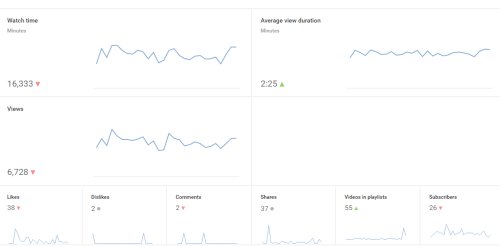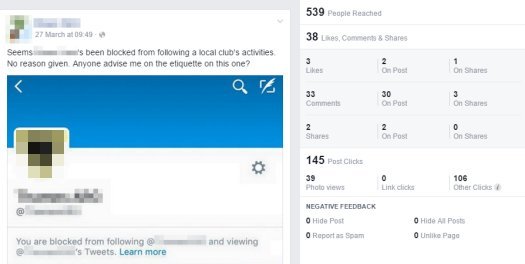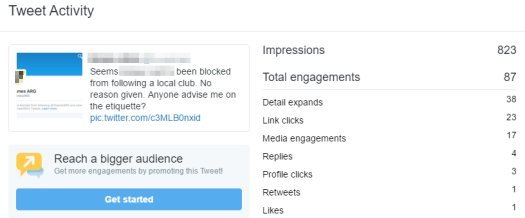Social Media – Managing bad PR… Badly
Last night saw the fourth week of the new Social Media Marketing in Southend.
To date, we’ve covered Facebook, Twitter (and a live Periscope!) plus LinkedIn. This week we looked at:
Instagram and Pinterest
Specialist platforms that have their uses, particularly for on online presence with a focus on images.
YouTube
Definitely an opportunity for growing your online userbase. We looked at channels, subscriptions, video editing tools, captions and handling comments, as well as what stats are available

Youtube Analytics – Who’s watching you!
Doing it wrong
One of the more interesting discussions of the evening related to demonstrating some of the ways that things can go wrong. Some of the class have had bad experiences of online reviews and inappropriate messages, and there’s concern from some about brand damage.
In recent weeks, a real-life example of a brand mis-managing social media has affected me, and the course discussion gave me the chance to dissect the problem in real-time, to highlight an example of an organisation handling a problem badly – as with all things, there’s a right and a wrong way to handle social media, and here’s an example of how not to do it.
Cooperative Promotion
First, some background. One of the online projects I’m involved with involves managing a community website, with around 500 users interacting via a WordPress community site, and social media. The site targets a niche market in a small geographical area. There are a dozen or so local groups in the target area, and the community site that I help with, tries to serve the market, whilst supporting the smaller geographic groups. In general, this works well, as the community site promotes the activities of the smaller local groups, providing promotion that the smaller groups may not be able to achieve.
One of the smaller groups prefers to operate as its own walled garden, without links to adjacent geographical groups, and elects not to partake in the wider community site’s promotion. As we have discussed throughout the course and as part of SEO, the more links and online interaction, the better. The following graph from 2013/14 demonstrates the impact that being part of a co-operative network can bring. The following, from ranking service Alexa, shows the dark blue group dropped from a rank of 5 million to over 12 million as a result of becoming a walled garden. The group represented by the light blue line had traditionally been performing poorly, but by joining the community, were able to gain and the expense of the former group, laregly through a better Google ranking and use of social media.

Community membership – Alexa ranking chart
You’re barred!!
In recent weeks, a real-life example of a brand mis-managing social media has crossed my path, and last night’s course discussion gave me the chance to dissect the problem in the classroom. This highlights an example of an organisation handling a problem badly – as with all things, there’s a right and a wrong way to handle social media, and here’s an example of how not to do it:
A negative comment, made in jest, was placed on the community website by one of the regulars. One of the local groups (or more likely, one individual) took exception to the comment, and elected to block them on Twitter.
As was discussed on our course, this is a largely pointless exercise. Twitter is a “broadcast” service, and so a blocked user can access content by simply logging out briefly.
In the face of a social media post that you don’t like, there are several options:
- Ignore the offending comment (usually best)
- Challenge the comment (direct response, counter-claim or defence)
- Force removal of the comment (Difficult and dangerous – See Streisand Effect)
Blocking the Twitter account of course achieved nothing. The offending message remained (unchallenged), and would have been lost down the timeline within 24 hours anyway.
What the act of blocking has done, is prevented the community site that I contribute to, from promoting the other group’s events and activities. Moreover, the reaction when the community discovered what had happened, it highlighted the foolishness of the ban to a much wider audience than saw the offending post in the first place.
A single social media message was posted announcing that our group had been blocked – and within a matter of days, it had reached 800 people on Twitter and 500 people on Facebook, as well as hundreds of others as a result of the tweet being discussed in an online forum. It’s been shared, retweeted, discussed and copied. The message received over 50 comments, largely condemning the action of the blocking group, and supporting the blocked group and the original poster.

Blocked Message – Facebook Stats

Blocked Message – Twitter Stats
As hopefully came across as part of the classroom discussion, the old adage of “all PR is good PR”, is true to an extent. Close to 2000 people (in a tiny niche market) saw that site A had blocked Site B, raising awareness for both brands. What it also shows is that with social media, the law of unexpected consequences so often applies – and it pays to know your audience.
The final week of the social media course is next week – a wrap-up on what’s been learnt so far, some brand analysis tools, and a workshop on how to grown a community.
Pete
Related links
- Thanks to Paul F for reminding me of the HMV Twitter classic: HMV Workers Twitter Feed Sacking
Add A Comment